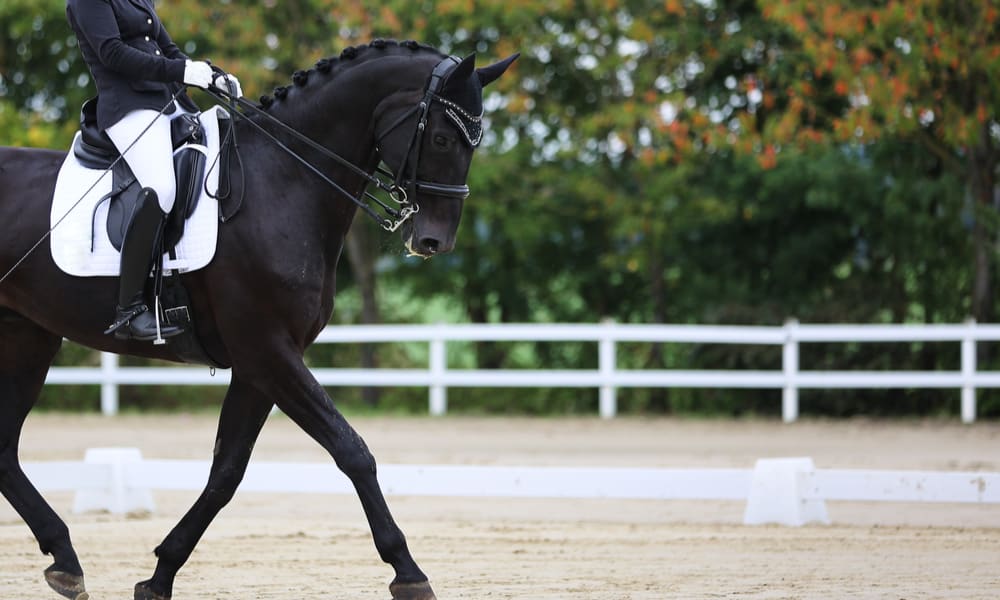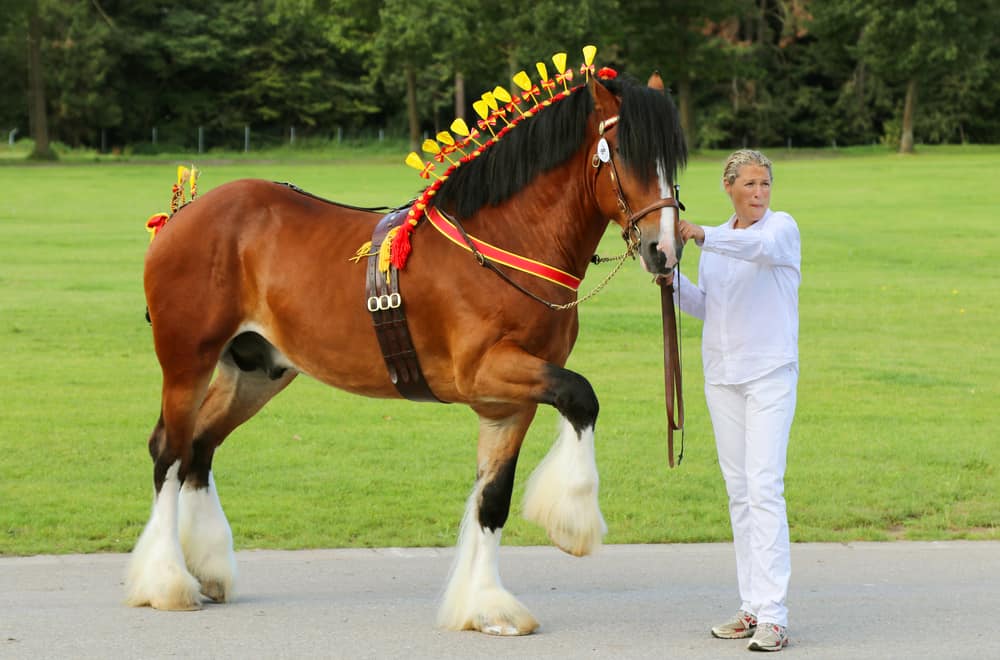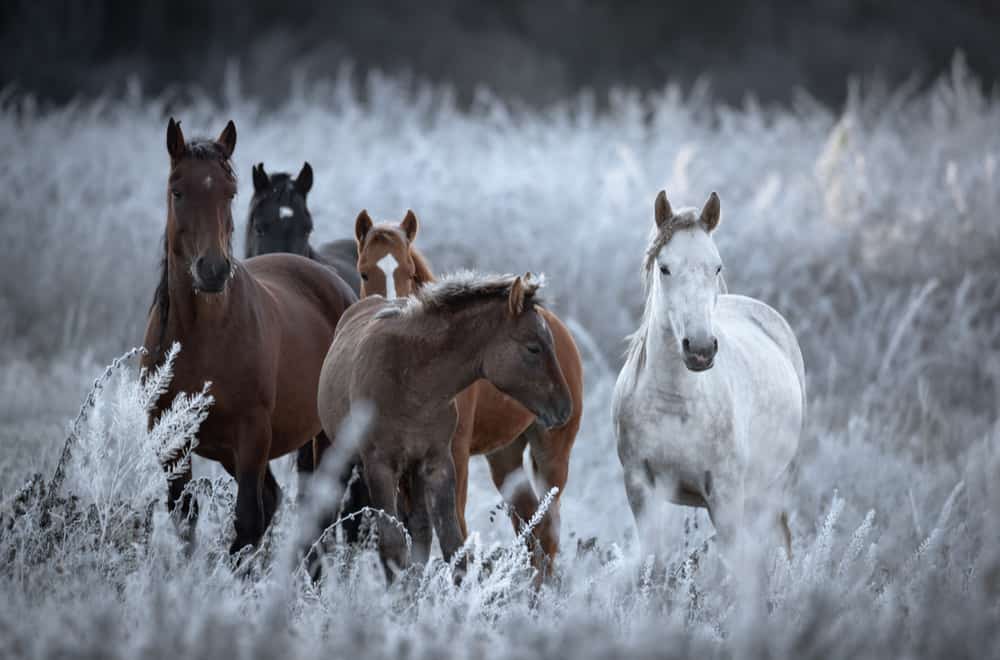You can find horses in different sizes, primarily depending on their genetics and breed. However, activity level and diet will significantly affect this trait, as well. It is crucial to measure your horse to pick out the correct animal according to your height.
There are a few ways to measure equines, with a stick, string, or measuring tape from the highest wither point to the ground. However, equestrians in English-speaking countries always calculate horse height in hands.
Why Measure Horses In Hands?
A hand is a traditional unit used to measure the horse’s height. Initially, people used handspan for this purpose, but there were too many variations, depending on different cultures.
King Henry VIII standardized the hand as 4 inches (10 cm) in England in 1540. As expected, other countries in the British Empire accepted the new measurement over time.
Even though the International Federation for Equestrian Sports and many countries use a metric system to determine a horse’s size nowadays, most English-speaking countries still use hands, including:
- The UK
- Ireland
- The USA
- Canada
- India
- Australia
- New Zealand
- South Africa
Besides the lack of measuring tools in the past, one of the primary reasons for using hands in determining the horse height was their pleasure. Many equestrians believe that horses prefer this method since it excludes measuring tape and sticks. These tools may make hypersensitive animals nervous.
Even though this explanation sounds very reasonable, there is no evidence to support it. In essence, it doesn’t matter if it is an urban legend or a reality. Hands remain the unit of measurement in the horse world, and it is unlikely that this will ever change.
How to Measure Horse Height?
Hand unit to inches
As I have already explained, the hand unit used to measure a horse is equal to 4 inches (10 cm). Establishing the ratio of these two units of measurement makes using this unique horse measuring system uncomplicated.
1 hh (hands high) = WH (whole hand number) x 4 inches (10 cm) + FH (hand fraction)
For instance, if you have a 15 hands tall horse, you will set the equation:
15 hands tall horse will have 15 x 4 + 0 = 60 inches (1.5 m)
However, it will look a bit different when the hand is not a whole number:
15.3 hands tall horse will have 15 x 4 + 3 = 63 inches (1.6 m)
Horse Types by Their Height
Even though some equestrians classify horses in five or even six groups, you will usually recognize three types based on their size. If you prefer being more precise, you can consider subcategories like Shetland, small, and draft horses.
Average horse height by horse type |
|||
| Type | Height in hands | Height in inches | Height in meters |
| Miniature | 6.2 to 8 hands | 24.8 to 32 inches | 0.63 to 0.81 m |
| Small | 8.2 to 9.2 hands | 34 to 38 inches | 0.86 to 0.97 m |
| Shetland | 10 to 11 hands | 40 to 44 inches | 1.02 to 1.12 m |
| Pony | 11.2 to 16 hands | 46 to 64 inches | 1.17 to 1.63 m |
| Horse | 14 to 18.2 hands | 56 to inches | 1.42 to m |
Horses
In Britain, any horse taller than 14.2 hands (58 inches / 1.47 m) is considered a member of a real horse group. In the US, this group includes animals tall from 13.3 to 17.3 hands (55 to 71 inches / 1.4 – 1.8 m).
Typically, most light riding horse breeds range from 14.2 to 16.2 hands (58 to 66 inches / 1.47 – 1.68 m), while large riding horses are 15.2 to 17 hands (62 to 68 inches / 1.57 – 1.73 m).
Heavy (draft) horses range from 16 to 18.2 hands (64 to 74 inches / 1.63 – 1.88 m). However, some animals can reach up to 19.2 hands (78 inches / 1.98 m).
Most riders choose medium-sized horses tall from 15 to 15.2 hands (60 to 62 inches / 1.52 – 1.57 m) as the most comfortable. On the other hand, novices find the smaller animals more pleasant for ride learning.
Average horse height by horse breed |
|||
| Breed | Height in hands | Height in inches | Height in meters |
| Suffolk Punch horse | 16.1 to 17.3 | 65 to 71 inches | 1.65 to 1.80 m |
| Oldenburg | 16 to 17.3 | 64 to 71 inches | 1.63 to 1.80 m |
| Clydesdale horse | 16 to 18 | 64 to 72 inches | 1.63 to 1.83 m |
| Shire | 16 to 17 | 64 to 68 inches | 1.63 to 1.73 m |
| Holsteiner | 16 to 17 | 64 to 68 inches | 1.63 to 1.73 m |
| Percheron | 16 to 17 | 64 to 68 inches | 1.63 to 1.73 m |
| Swedish Warmblood | 16 to 17 | 64 to 68 inches | 1.63 to 1.73 m |
| Shire horse | 16 to 17 | 64 to 68 inches | 1.63 to 1.73 m |
| Cleveland bay horse | 16 to 16.2 | 64 to 66 inches | 1.63 to 1.68 m |
| Hanoverian horse | 15.3 to 17.2 | 63 to 70 inches | 1.60 to 1.78 m |
| Trakehner | 15.3 to 17 | 63 to 68 inches | 1.60 to 1.73 m |
| Suffolk | 15.3 to 17 | 63 to 68 inches | 1.60 to 1.73 m |
| Ardennes horse | 15.3 to 16.1 | 63 to 65 inches | 1.60 to 1.65 m |
| Irish Draught | 15.3 to 16.1 | 63 to 65 inches | 1.60 to 1.65 m |
| Westphalian horse | 15.2 to 17.2 | 62 to 70 inches | 1.57 to 1.78 m |
| Thoroughbred horse | 15.2 to 17.2 | 62 to 70 inches | 1.57 to 1.78 m |
| Irish draught horse | 15.1 to 16.3 | 61 to 63 inches | 1.55 to 1.60 m |
| Belgian Draft | 15 to 17.3 | 60 to 71 inches | 1.52 to 1.80 m |
| American Warmblood | 15 to 17 | 60 to 68 inches | 1.52 to 1.73 m |
| Orlov Trotter | 15 to 17 | 60 to 68 inches | 1.52 to 1.73 m |
| Dutch Warmblood | 15 to 17 | 60 to 68 inches | 1.52 to 1.73 m |
| American Cream draft | 15 to 17 | 60 to 68 inches | 1.52 to 1.73 m |
| Hackney | 15 to 16.2 | 60 to 66 inches | 1.52 to 1.68 m |
| Andalusian | 15 to 16.1 | 60 to 65 inches | 1.52 to 1.65 m |
| American Saddlebred | 15 to 16.1 | 60 to 65 inches | 1.52 to 1.65 m |
| Paint horse | 15 to 16 | 60 to 64 inches | 1.52 to 1.63 m |
| Criollo | 15 to 15.3 | 60 to 63 inches | 1.52 to 1.60 m |
| Lipizzaner | 15 to 15.3 | 60 to 63 inches | 1.52 to 1.60 m |
| Tennessee Walker | 15 to 15.1 | 60 to 61 inches | 1.52 to 1.55 m |
| Hackney horse | 14.2 to 16.2 | 58 to 66 inches | 1.47 to 1.68 m |
| Arabian horse | 14.1 to 15.1 | 57 to 61 inches | 1.45 to 1.55 m |
| Paso Fino | 14.1 to 15 | 57 to 60 inches | 1.45 to 1.52 m |
| American Quarter horse | 14 to 16.1 | 56 to 65 inches | 1.42 to 1.65 m |
| Appaloosa | 14 to 15.3 | 56 to 63 inches | 1.42 to 1.60 m |
| Walkaloosa | 14 to 15 | 56 to 60 inches | 1.42 to 1.52 m |
| Morgan | 14 to 15 | 56 to 60 inches | 1.42 to 1.52 m |
| American Standardbred | 14 to 15 | 56 to 60 inches | 1.42 to 1.52 m |
| Halfinger | 13.2 to 15 | 54 to 60 inches | 1.40 to 1.52 m |
| Fell pony | 13.2 to 14 | 54 to 56 inches | 1.37 to 1.42 m |
| Gypsy Vanner | 13 to 16 | 52 to 64 inches | 1.32 to 1.63 m |
| Highland pony | 13 to 14.2 | 52 to 58 inches | 1.32 to 1.47 m |
| Dales pony | 13 to 14 | 52 to 56 inches | 1.32 to 1.42 m |
| Connemara pony | 12.2 to 14.2 | 50 to 58 inches | 1.27 to 1.47 m |
| Welsh pony | 12.2 to 13.2 | 50 to 54 inches | 1.27 to 1.37 m |
| New Forest pony | 12 to 14.2 | 48 to 58 inches | 1.22 to 1.47 m |
| Hackney pony | 12 to 14 | 48 to 56 inches | 1.22 to 1.42 m |
| Spanish Mustang | 12 to 14 | 48 to 56 inches | 1.22 to 1.42 m |
| Eriskay pony | 12 to 13.2 | 48 to 54 inches | 1.22 to 1.37 m |
| Welara | 11.2 to 15 | 46 to 60 inches | 1.17 to 1.52m |
| Exmoor pony | 11.1 to 12.3 | 45 to 51 inches | 1.14 to 1.3 m |
| Dartmoor pony | 11.1 to 12.2 | 45 to 50 inches | 1.14 to 1.27 m |
| Spotted pony | 8 to 14 | 32 to 56 inches | 0.81 to 1.42m |
| Shetland pony | 7 to 10.2 | 28 to 42 inches | 0.71 to 1.07m |
Ponies
These horses are 10 to 13.2 hands (40 to 54 inches / 1 – 1.4 m) tall. Even though you can find small, medium, and large pony types, only those under 14.2 hands (58 inches / 1.47 m) in height are considered ponies in UK competitions.
Miniatures
Breeders created these dwarf horses by separating genes related to height and chose shortness as a desirable trait. You can’t use this toy horse for racing or work, but it will be an ideal option as a pet or for cart driving.
You can consider a horse miniature when lower than 8 hands (32 inches / 0.81 m). However, some classification types include all animals under 9.2 hands (38 inches / 0.96 m) in this category.
Summary
When deciding to measure your horse, you can be confused with the different standards used. Be prepared that most English-speaking countries still use a hand as a traditional unit. If you live in a country that uses a standard metric, British imperial or the US customary systems, you should learn to compare them.










